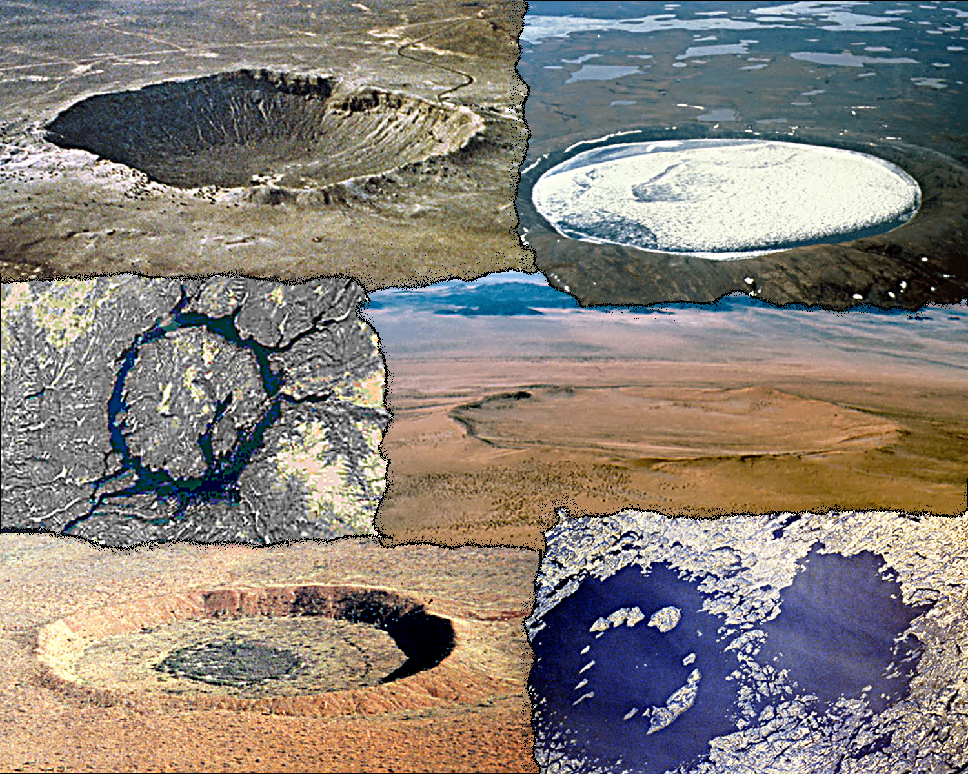
For the week including November 26, 2010

ANCIENT IMPACTS
One look at the Moon shows that it has been hit by many large meteors over the ages. But our planet, although it presents a much bigger target, has largely escaped because most meteors burn up in our atmosphere before they can do much damage. It wasn’t until the 1900s that we found out that the Earth hadn’t entirely escaped.
Out near a desert plateau in Arizona, is a huge circular depression in the earth surrounded by a peculiar arching rim of rock. For decades Coon Butte was thought to be the remains of an extinct volcano, a reminder of the Earth’s more violent past. But fragments of iron meteorites were plentiful in the area surrounding the butte and in 1905 Daniel Barringer began exploring the big hole in the ground to test his theory that a large meteor had carved it out. His findings showed that the region had no volcanic origin and layers of rock had been crushed by an object moving with incredible force and speed. The area, shown in the upper left photograph, is now known as Barringer Meteor Crater, Arizona. This was the first impact site to be identified and some 160 have been found since.
At upper right is the Pingualuit crater in New Quebec, Canada. Here a meteor strike punched through the water table and shaped a large crater lake. The walls of its rim rise some 450 feet above the surrounding terrain while the crater itself plunges to a depth of 750 feet. An analysis of the rock layers involved at the time of collision give this crater a possible age of nearly a million years. Erosion has carried away most of the clues about the size of the meteor, but molten rocks have been found up to two miles away from the crater.
A different kind of crater lake is shown at middle left. Drop a pebble into a pond and you can watch a circle of waves spread out along its surface. This same effect created the magnificent Manicouagan Lake in Quebec. Water has filled one of the rings formed by the meteor impact producing a lake 70 kilometers in diameter. While most of the rest of the crater has eroded away, its original size is estimated to have been 100 kilometers across, making it one of the largest meteor related formations known.
The desert, though, has its own beauty. The photograph at center right is the Roter Kamm (Red Crest) Crater in Namibia. Rolling dunes nearly fill this crater and the effects of wind blown sand have greatly eroded the walls of its rim. About a mile and half across and with an original depth of some seven hundred feet, scientists calculate the Roter Kamm to be nearly five million years old.
At lower left is Wolf Creek crater in Australia. Because it sat in a little traveled area, the crater wasn’t discovered until an airplane overflew it in 1937. After Barringer Crater, this is probably the best preserved impact site known. With an estimated age of 300,000 years, Wolf Creek crater is 2,700 feet across and 450 feet deep. NASA sent astronauts here to learn what craters on the Moon might be like.
As the lower right photograph shows, sometimes meteors don’t travel alone. The Clearwater Lakes in Canada were created by twin impacts. The exposed shock ring in the left-hand lake is ten kilometers wide.
The Barringer Crater photograph is by D. Roddy
The Pingualuit crater photograph is by George Burnside
The photographs of Manicouagan Crater the Clearwater Lakes are from NASA.
The Roter Kamm photograph is by Christian Koeberl
The Wolf Creek crater photograph is by V.L. Sharpton
Unless otherwise indicated, all content of this web site is the copyright of Robert Deegan and all rights are reserved.
For more information, or to comment, please contact: Bob@NightSkies.org